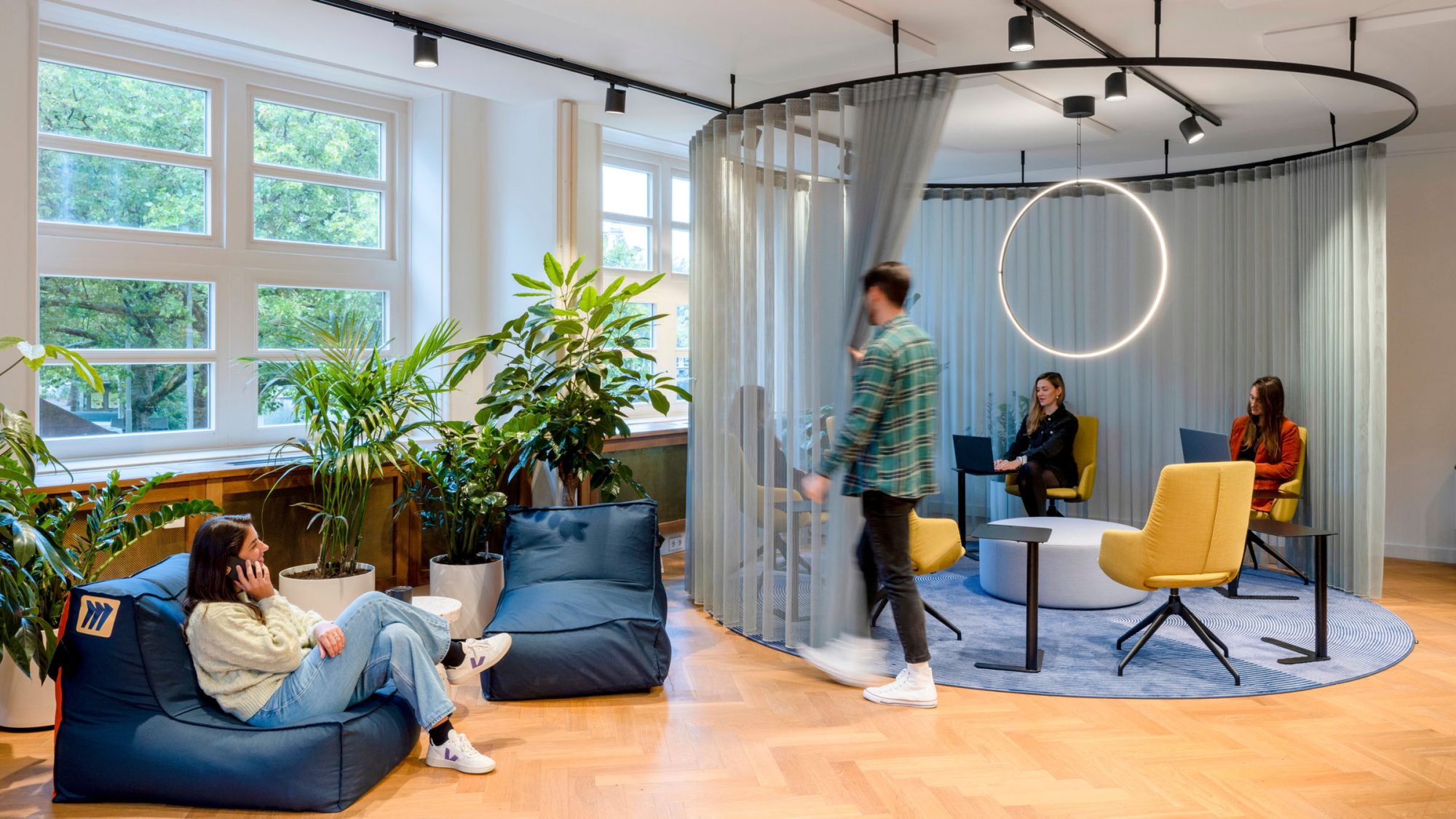As hybrid work becomes increasingly common, companies around the world are adapting to this flexible arrangement, allowing employees to split time between home, office, and remote locations. Flexible workspaces have emerged as a critical asset in supporting this trend, offering remote teams a dynamic environment that balances productivity, collaboration, and convenience.
This article explores the rise of hybrid work, the benefits of flexible workspaces for remote teams, and how they are helping organizations redefine traditional work culture.
Understanding Hybrid Work and Its Growing Popularity
What is Hybrid Work?
Hybrid work is a model that combines remote and in-office work, offering employees the flexibility to choose where they work best based on their tasks and preferences. This approach typically allows employees to work part of the week at home and the remainder in a professional setting, blending the autonomy of remote work with the collaborative benefits of office time.
Why Hybrid Work is Here to Stay
Hybrid work has gained significant traction over the last few years as companies recognized its potential to boost employee satisfaction, improve work-life balance, and increase productivity. A recent survey found that nearly 75% of employees would prefer a hybrid working model over a traditional in-office setup. With these statistics in mind, organizations are shifting to hybrid work to attract top talent, enhance retention, and stay competitive in today’s globalized economy.
The Role of Flexible Workspaces in a Hybrid Work Model
Flexible workspaces—coworking spaces, hot desks, shared offices, and virtual workstations—play a key role in making hybrid work more effective. They provide remote teams with a professional setting outside the home, where employees can access high-quality resources, connect with coworkers, and maintain productivity.
Bridging the Gap Between Remote and Office Work
Flexible workspaces offer a seamless transition between remote and office work. Employees can access a nearby coworking space or shared office as needed, cutting down commute times and enabling a smoother workday. For organizations, this means they can maintain team cohesion and foster a professional work culture without requiring employees to come into the main office every day.
Supporting a Distributed Workforce
For companies with teams spread across different locations, flexible workspaces provide a convenient and cost-effective way to establish a presence in multiple areas. With flexible workspaces, companies can support remote employees from various regions, ensuring that everyone has access to the resources and environment they need, regardless of location.
Key Benefits of Flexible Workspaces for Remote Teams
1. Enhanced Collaboration and Team Building
Hybrid work models often require employees to collaborate across locations, and flexible workspaces support this by providing meeting rooms, collaborative zones, and conference facilities. These spaces allow remote teams to come together for strategy sessions, brainstorming meetings, or social gatherings, fostering a sense of team unity.
Encouraging Face-to-Face Interactions
While virtual communication tools are essential for remote teams, in-person interactions still play a critical role in building trust and relationships. Flexible workspaces enable teams to meet face-to-face as needed, enhancing team dynamics, boosting morale, and creating stronger bonds among colleagues.
2. Improved Work-Life Balance and Employee Satisfaction
Flexible workspaces provide employees with a change of scenery and a structured environment, which can help them maintain a healthy work-life balance. For those who find it challenging to work from home due to distractions or lack of dedicated space, these workspaces offer a focused and productive setting.
Accessible and Convenient Locations
Many flexible workspaces are situated in central or convenient locations, reducing the need for long commutes. Employees can choose to work in locations closer to home, which allows them to reclaim time typically spent commuting and achieve a better work-life balance.
3. Access to Premium Amenities and Professional Resources
Flexible workspaces are equipped with modern amenities—high-speed internet, video conferencing tools, and meeting rooms—that help remote employees perform at their best. This access allows remote teams to work effectively without the limitations of a home setup.
Technological Support for Remote Teams
Many flexible workspaces provide advanced tech support, ensuring remote teams have access to the tools they need to communicate and collaborate effectively. This includes high-quality Wi-Fi, secure cloud access, projectors, and other tech essentials. For remote teams relying on digital platforms for collaboration, having access to such resources in a professional workspace can be highly advantageous.
4. Cost Efficiency and Scalability for Businesses
Flexible workspaces offer an affordable solution for companies looking to support a hybrid workforce without investing in large, permanent office spaces. Companies can rent these spaces as needed, minimizing overhead costs while still providing employees with a professional setting.
Flexibility to Scale as Needed
For growing companies or those in transition, flexible workspaces offer an adaptable solution that can scale with business needs. Whether a team size fluctuates seasonally or a company is expanding into new regions, flexible workspaces provide a cost-effective and scalable option for accommodating changes.
5. Boosting Creativity and Innovation
Working in a flexible, community-focused environment can inspire creativity and innovation. Many flexible workspaces are designed to be visually stimulating and include breakout zones, communal areas, and lounges that encourage social interaction and spontaneous idea-sharing.
Exposure to Diverse Perspectives
Flexible workspaces are often populated by a variety of professionals from different fields, offering employees the chance to connect with others outside their team or industry. This exposure to diverse perspectives can lead to creative insights and fresh ideas that benefit both the employee and the organization.
How Flexible Workspaces Support Hybrid Work at an Organizational Level
Fostering a Culture of Flexibility and Trust
By incorporating flexible workspaces into their hybrid work policies, companies can show employees that they value their autonomy and trust their ability to work effectively in different environments. This culture of flexibility empowers employees, boosting job satisfaction and fostering loyalty.
Simplifying Logistics and Reducing Overhead
For companies managing a dispersed workforce, flexible workspaces simplify logistics, allowing employees to access local offices or coworking spaces. This setup reduces the need for a large central office, cutting down on overhead costs like rent, utilities, and maintenance.
Enhancing Talent Attraction and Retention
The availability of flexible workspaces can be a major attraction for job candidates who prioritize work-life balance, convenience, and flexibility. Offering access to flexible workspaces can differentiate a company from its competitors, making it an appealing choice for top talent and contributing to higher retention rates.
Future Trends: Flexible Workspaces in the Hybrid Work Landscape
As hybrid work continues to gain popularity, flexible workspaces are evolving to better meet the needs of remote teams and businesses. Here are some emerging trends shaping the future of flexible workspaces in the hybrid work environment.
Increased Demand for Technology-Driven Workspaces
With advancements in remote work technology, flexible workspaces are integrating digital tools like AI-driven scheduling, VR meeting rooms, and touchless technology for a seamless and efficient experience. These tech-enhanced spaces cater to remote teams who rely on digital platforms for productivity.
Wellness-Focused Environments
Workspaces designed with wellness in mind are becoming more common, offering quiet zones, ergonomic furniture, and wellness rooms to support mental and physical health. These wellness-focused spaces help employees feel comfortable and relaxed, promoting a positive work experience even when working away from home.
The Growth of “Hub-and-Spoke” Models
As companies look to reduce overhead, many are adopting a “hub-and-spoke” model—where a central headquarters serves as a hub, and smaller, local offices or flexible workspaces act as spokes. This setup allows employees to access a professional workspace without commuting to a distant central office, making it easier to manage a distributed workforce.
Conclusion: Why Flexible Workspaces Are Essential in a Hybrid World
Flexible workspaces have proven essential for organizations embracing the hybrid work model. By offering a productive, collaborative, and adaptable environment, these spaces help bridge the gap between remote and in-office work, providing a seamless experience that enhances both employee satisfaction and company performance.
Whether it’s fostering team collaboration, enhancing productivity, or supporting employee well-being, flexible workspaces are positioned to play a pivotal role in the future of work. As hybrid work continues to evolve, these spaces will remain integral to helping remote teams stay connected, productive, and engaged in a flexible and supportive work environment.


